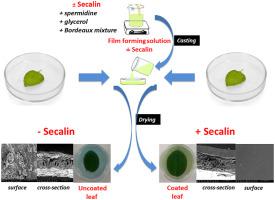Journal of Cleaner Production ( IF 9.7 ) Pub Date : 2021-10-25 , DOI: 10.1016/j.jclepro.2021.129461 Zeinab Qazanfarzadeh 1, 2 , Seyedeh Fatemeh Mirpoor 2 , Mahdi Kadivar 1 , Hajar Shekarchizadeh 1 , Rocco Di Girolamo 2 , C. Valeria L. Giosafatto 2, 3 , Prospero Di Pierro 2, 3 , Raffaele Porta 2, 3

|
The effects of spermidine (SPD) on the properties of both secalin (SCL)-based film-forming solutions (FFSs) and their resultant films were studied in the absence or presence of glycerol (GLY) used as primary plasticizer. The average size of SCL particles significantly increased with the increase of SPD concentration, mainly in the presence of GLY, while the negative zeta potential values parallely decreased suggesting a greater stability of the FFSs containing SPD concentrations lower than 1.0 mM. In addition, the decreased contact angle value, compared to water and ethanol solution, indicated that SCL FFSs were highly hydrophobic and that it might be spreaded easily on hydrophobic biological surfaces. SPD could replace GLY in obtaining handleable, homogeneous and performing SCL-based films. The film tensile strength and the Young's module strongly increased in the absence of GLY, reaching values higher than 5 times with respect to controls, whereas elongation at break value of GLY-plasticized films containing 5.0 mM SPD was twice of that of the films prepared without SPD. Conversely, the film moisture content, water solubility and swelling ratio progressively decreased, both in the presence and absence of GLY, up to a SPD concentration of 1.0 mM, whereas the film contact angle increased, confirming the enhancement of its hydrophobicity determined by SPD incorporation. SPD also increased the film barrier properties to gases and water vapor, while the presence of GLY hindered these effects. Finally, SEM analysis of the cross-sections of the SPD containing films showed heterogeneous microstructures, whereas their surfaces appeared rougher than those of the control films. Preliminary experiments carried out by Rosa chinensis Jacq. leaf coating suggest the potential use of SCL-based FFSs spraying in plant disease control. High spreading of the SCL-based FFSs on the entire leaf surfaces, both in the presence and absence of Bordeaux mixture tested as agrochemical, was observed, and the SEM images showed the formation of an evident coating of the leaves. Therefore, these findings suggest the possibility to coat the leaf surface also in vivo with different SCL-based FFSs, giving rise to films possessing tailored functional properties and able to carry and release different agrochemicals.
中文翻译:

甘油和/或亚精胺增塑的 secalin 薄膜作为可持续植物病害管理的叶面涂层的潜在用途
在不存在或存在用作主要增塑剂的甘油 (GLY) 的情况下,研究了亚精胺 (SPD) 对基于 secalin (SCL) 的成膜溶液 (FFS) 及其所得薄膜的性质的影响。SCL 颗粒的平均尺寸随着 SPD 浓度的增加而显着增加,主要是在 GLY 的存在下,而负 zeta 电位值同时降低,表明 SPD 浓度低于 1.0 mM 的 FFS 具有更大的稳定性。此外,与水和乙醇溶液相比,接触角值的降低表明 SCL FFS 具有高度疏水性,并且很容易在疏水性生物表面上扩散。SPD 可以替代 GLY 获得可处理、均质和性能良好的基于 SCL 的薄膜。薄膜拉伸强度和杨氏 在没有 GLY 的情况下,s 模量显着增加,达到高于对照的 5 倍的值,而含有 5.0 mM SPD 的 GLY 增塑薄膜的断裂伸长率是没有 SPD 制备的薄膜的两倍。相反,在存在和不存在 GLY 的情况下,薄膜的含水量、水溶性和溶胀率逐渐降低,直到 SPD 浓度为 1.0 mM,而薄膜接触角增加,证实了由 SPD 掺入决定的疏水性增强. SPD 还增加了薄膜对气体和水蒸气的阻隔性能,而 GLY 的存在阻碍了这些效果。最后,包含 SPD 的薄膜横截面的 SEM 分析显示出不均匀的微观结构,而它们的表面看起来比对照薄膜的表面更粗糙。中华蔷薇。叶涂层表明基于 SCL 的 FFS 喷洒在植物病害控制中的潜在用途。观察到基于 SCL 的 FFS 在整个叶子表面上的高度扩散,无论是在作为农用化学品测试的波尔多混合物存在还是不存在的情况下,都被观察到,并且 SEM 图像显示形成了明显的叶子涂层。因此,这些发现表明在体内也可以用不同的基于 SCL 的 FFS 覆盖叶表面,从而产生具有定制功能特性并能够携带和释放不同农用化学品的薄膜。

































 京公网安备 11010802027423号
京公网安备 11010802027423号